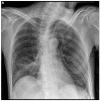Association of Broad-Spectrum Antibiotic Therapy and Vitamin E Supplementation with Vitamin K Deficiency-Induced Coagulopathy: A Case Report and Narrative Review of the Literature
- PMID: 37763117
- PMCID: PMC10533186
- DOI: 10.3390/jpm13091349
Association of Broad-Spectrum Antibiotic Therapy and Vitamin E Supplementation with Vitamin K Deficiency-Induced Coagulopathy: A Case Report and Narrative Review of the Literature
Abstract
Vitamin K is a lipid-soluble vitamin that is normally maintained within appropriate levels by means of dietary intake and bacterial production in the intestinal microflora. It holds a central role in coagulation homeostasis, and thus its depletion leads to hypocoagulation and haemorrhagic diathesis. The association of antibiotic therapy and vitamin E supplementation with vitamin K deficiency was previously described in animal experiments, clinical studies, and case reports. Broad-spectrum antibiotic therapy potentially leads to intestinal microflora dysbiosis and restriction of vitamin K-producing bacterial populations, resulting in decreased vitamin K levels, whereas antibiotics of the cephalosporin class with 1-N-methyl-5-thiotetrazole (NMTT) or 2-methyl-1,3,4-thiadiazole (MTD) side groups inhibit vitamin K function. Vitamin E supplementation interferes with both the bioavailability and function of vitamin K, yet its mechanisms are not fully understood. We present the case of a 45-year-old male patient, with a history of epilepsy and schizophrenia, catatonically incapacitated and immobilised, who was hospitalised in our centre for the investigation and management of aspiration pneumonia. He demonstrated a progressively worsening prolongation of international normalised ratio (INR), which was attributed to both broad-spectrum antibiotic therapy and vitamin E supplementation and was reversed upon administration of vitamin K. We highlight the need for close monitoring of coagulation parameters in patients receiving broad-spectrum antibiotic therapy, especially those with underlying malnutritive or malabsorptive conditions, and we further recommend the avoidance of NMTT- or MTD-containing antibiotics or vitamin E supplementation, unless absolutely necessary, in those patients.
Keywords: antibiotics; coagulopathy; international normalised ratio; prothrombin time; vitamin E; vitamin K.
Conflict of interest statement
The authors declare no conflict of interest.
Figures




References
-
- Pazirandeh S., Burns D.L., Post T.W., editors. Overview of Vitamin K. UpToDate Inc.; Waltham, MA, USA: 2023. [(accessed on 24 July 2023)]. Available online: https://www.uptodate.com/contents/overview-of-vitamin-k.
-
- Furie B., Bouchard B.A., Post T.W., editors. Vitamin K and the Synthesis and Function of Gamma-Carboxyglutamic Acid. UpToDate Inc.; Waltham, MA, USA: 2023. [(accessed on 16 August 2023)]. Available online: https://www.uptodate.com/contents/vitamin-k-and-the-synthesis-and-functi....
Publication types
LinkOut - more resources
Full Text Sources

